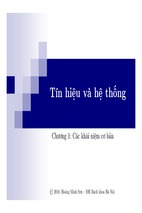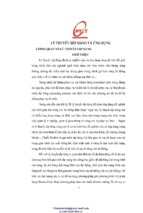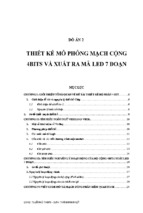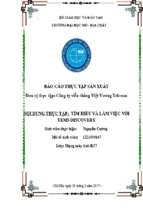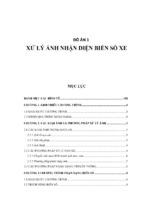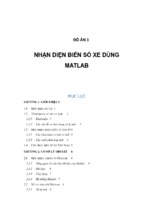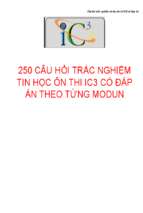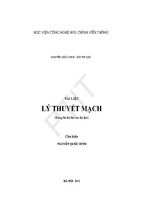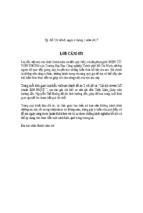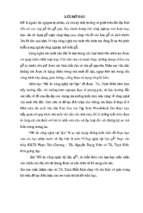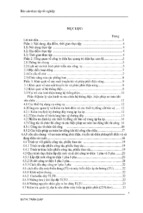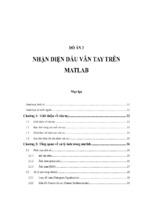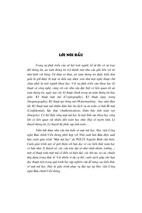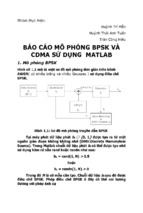Principles of Communication 5Ed R. E. Zeimer, William H Tranter Solutions Manual
Chapter 2
Signal and Linear System Theory
2.1
Problem Solutions
Problem 2.1
For the single-sided spectra, write the signal in terms of cosines:
x(t) = 10 cos(4πt + π/8) + 6 sin(8πt + 3π/4)
= 10 cos(4πt + π/8) + 6 cos(8πt + 3π/4 − π/2)
= 10 cos(4πt + π/8) + 6 cos(8πt + π/4)
For the double-sided spectra, write the signal in terms of complex exponentials using Euler’s
theorem:
x(t) = 5 exp[(4πt + π/8)] + 5 exp[−j(4πt + π/8)]
+3 exp[j(8πt + 3π/4)] + 3 exp[−j(8πt + 3π/4)]
The two sets of spectra are plotted in Figures 2.1 and 2.2.
Problem 2.2
The result is
x(t) = 4ej(8πt+π/2) + 4e−j(8πt+π/2) + 2ej(4πt−π/4) + 2e−j(4πt−π/4)
= 8 cos (8πt + π/2) + 4 cos (4πt − π/4)
= −8 sin (8πt) + 4 cos (4πt − π/4)
1
2
CHAPTER 2. SIGNAL AND LINEAR SYSTEM THEORY
Single-sided amplitude
Single-sided phase, rad.
10
π/4
5
π/8
f, Hz
0
2
4
6
f, Hz
0
2
4
6
Figure 2.1:
Problem 2.3
(a) Not periodic.
(b) Periodic. To find the period, note that
20π
6π
= n1 f0 and
= n2 f0
2π
2π
Therefore
n2
10
=
3
n1
Hence, take n1 = 3, n2 = 10, and f0 = 1 Hz.
(c) Periodic. Using a similar procedure as used in (b), we find that n1 = 2, n2 = 7, and
f0 = 1 Hz.
(d) Periodic. Using a similar procedure as used in (b), we find that n1 = 2, n2 = 3, n3 = 11,
and f0 = 1 Hz.
Problem 2.4
(a) The single-sided amplitude spectrum consists of a single line of height 5 at frequency 6
Hz, and the phase spectrum consists of a single line of height -π/6 radians at frequency 6
Hz. The double-sided amplitude spectrum consists of lines of height 2.5 at frequencies of
6 and -6 Hz, and the double-sided phase spectrum consists of a line of height -π/6 radians
at frequency 6 Hz and a line of height π/6 at frequency -6 radians Hz.
(b) Write the signal as
xb (t) = 3 cos(12πt − π/2) + 4 cos(16πt)
From this it is seen that the single-sided amplitude spectrum consists of lines of height 3
and 4 at frequencies 6 and 8 Hz, respectively, and the single-sided phase spectrum consists
2.1. PROBLEM SOLUTIONS
3
Double-sided amplitude
5
f, Hz
-6
-4
-2
0
2
4
6
Double-sided phase, rad.
π/4
π/8
-6
-4
-2
f, Hz
0
2
-π/8
-π/4
Figure 2.2:
4
6
4
CHAPTER 2. SIGNAL AND LINEAR SYSTEM THEORY
of a line of height -π/2 radians at frequency 6 Hz. The double-sided amplitude spectrum
consists of lines of height 1.5 and 2 at frequencies of 6 and 8 Hz, respectively, and lines of
height 1.5 and 2 at frequencies -6 and -8 Hz, respectively. The double-sided phase spectrum
consists of a line of height -π/2 radians at frequency 6 Hz and a line of height π/2 radians
at frequency -6 Hz.
Problem 2.5
(a) This function has area
Area =
=
Z∞
−∞
Z∞
−∞
−1
²
·
·
sin(πt/²)
(πt/²)
sin(πu)
(πu)
¸2
¸2
dt
du = 1
A sketch shows that no matter how small ² is, the area is still 1. With ² → 0, the central
lobe of the function becomes narrower and higher. Thus, in the limit, it approximates a
delta function.
(b) The area for the function is
Area =
Z∞
1
exp(−t/²)u (t) dt =
²
−∞
Z∞
exp(−u)du = 1
0
A sketch shows that no matter how small ² is, the area is still 1. With ² → 0, the function
becomes narrower
and higher. Thus,
R 1 in the limit, it approximates a delta function.
R²
(c) Area = −² 1² (1 − |t| /²) dt = −1 Λ (t) dt = 1. As ² → 0, the function becomes narrower
and higher, so it approximates a delta function in the limit.
Problem 2.6
(a) 513; (b) 183; (c) 0; (d) 95,583.8; (e) -157.9.
Problem 2.7
(a), (c), (e), and (f) are periodic. Their periods are 1 s, 4 s, 3 s, and 2/7 s, respectively.
The waveform of part (c) is a periodic train of impulses extending from -∞ to ∞ spaced
by 4 s. The waveform of part (a) is a complex sum of sinusoids that repeats (plot). The
waveform of part (e) is a doubly-infinite train of square pulses, each of which is one unit
high and one unit wide, centered at · · ·, −6, −3, 0, 3, 6, · · ·. Waveform (f) is a raised
cosine of minimum and maximum amplitudes 0 and 2, respectively.
2.1. PROBLEM SOLUTIONS
5
Problem 2.8
(a) The result is
³
´
h
i
¢
¡
x(t) = Re ej6πt + 6 Re ej(12πt−π/2) = Re ej6πt + 6ej(12πt−π/2)
(b) The result is
1
1
x(t) = ej6πt + e−j6πt + 3ej(12πt−π/2) + 3e−j(12πt−π/2)
2
2
(c) The single-sided amplitude spectrum consists of lines of height 1 and 6 at frequencies
of 3 and 6 Hz, respectively. The single-sided phase spectrum consists of a line of height
−π/2 at frequency 6 Hz. The double-sided amplitude spectrum consists of lines of height
3, 1/2, 1/2, and 3 at frequencies of −6, −3, 3, and 6 Hz, respectively. The double-sided
phase spectrum consists of lines of height π/2 and −π/2 at frequencies of −6 and 6 Hz,
respectively.
Problem 2.9
(a) Power. Since it is a periodic signal, we obtain
1
P1 =
T0
Z
0
T0
1
4 sin (8πt + π/4) dt =
T0
2
Z
T0
2 [1 − cos (16πt + π/2)] dt = 2 W
0
where T0 = 1/8 s is the period.
(b) Energy. The energy is
Z ∞
Z
E2 =
e−2αt u2 (t)dt =
−∞
∞
e−2αt dt =
1
2α
e2αt dt =
1
2α
0
(c) Energy. The energy is
E3 =
Z
∞
e2αt u2 (−t)dt =
−∞
Z
0
−∞
(d) Neither energy or power.
E4 = lim
Z
T
T →∞ −T (α2
P4 = 0 since limT →∞
1
T
RT
dt
−T (α2 +t2 )1/4
dt
+ t2 )1/4
= 0.(e) Energy.
=∞
Since it is the sum of x1 (t) and
x2 (t), its energy is the sum of the energies of these two signals, or E5 = 1/α.
6
CHAPTER 2. SIGNAL AND LINEAR SYSTEM THEORY
(f) Power. Since it is an aperiodic signal (the sine starts at t = 0), we use
Z T
1
1
[1 − cos (10πt)] dt
T
→∞
2T
0
0 2
·
¸
1 T
1
1 sin (20πt) T
= W
−
= lim
T →∞ 2T
2
2 20π
4
0
P6 =
1
T →∞ 2T
lim
Z
T
sin2 (5πt) dt = lim
Problem 2.10
(a) Power. Since the signal is periodic with period π/ω, we have
P =
ω
π
Z
π/ω
0
A2 |sin (ωt + θ)|2 dt =
ω
π
Z
π/ω
0
A2
A2
{1 − cos [2 (ωt + θ)]} dt =
2
2
(b) Neither. The energy calculation gives
E = lim
Z
T
T →∞ −T
(Aτ )2 dt
√
√
= lim
τ + jt τ − jt T →∞
Z
T
−T
(Aτ )2 dt
√
→∞
τ 2 + t2
The power calculation gives
1
P = lim
T →∞ 2T
Z
T
−T
(Aτ )2 dt
(Aτ )2
√
= lim
ln
τ 2 + t2 T →∞ 2T
Ã
!
p
1 + T 2 /τ 2
p
=0
−1 + 1 + T 2 /τ 2
1+
(c) Energy:
E=
Z
0
∞
3
A2 t4 exp (−2t/τ ) dt = A2 τ 5 (use table of integrals)
4
(d) Energy:
E=2
ÃZ
0
τ /2
22 dt +
Z
τ
τ /2
!
12 dt
= 5τ
Problem 2.11
(a) This is a periodic train of “boxcars”, each 3 units in width and centered at multiples of
6:
µ ¶
Z
Z
1 3 2 t
1
1 1.5
Π
dt = W
dt =
Pa =
6 −3
3
6 −1.5
2
2.1. PROBLEM SOLUTIONS
7
(b) This is a periodic train of unit-high isoceles triangles, each 4 units wide and centered
at multiples of 5:
¶
µ
¶ ¯2
µ ¶
Z
Z µ
2 2
t 3 ¯¯
t 2
1 2.5 2 t
22
4
dt =
1−
W
1−
Pb =
Λ
dt = −
¯ =
5 −2.5
2
5 0
2
53
2 ¯
15
0
(c) This is a backward train of sawtooths (right triangles with the right angle on the left),
each 2 units wide and spaced by 3 units:
¶
µ
¶ ¯2
Z µ
t 2
1 2
12
2
t 3 ¯¯
1−
dt = −
1−
Pc =
¯ = W
3 0
2
33
2 ¯
9
0
(d) This is a full-wave rectified cosine wave of period 1/5 (the width of each cosine pulse):
¸
Z 1/10
Z 1/10 ·
1
1 1
2
|cos (5πt)| dt = 2 × 5
Pd = 5
+ cos (10πt) dt = W
2 2
2
−1/10
0
Problem 2.12
(a) E = ∞, P = ∞; (b) E = 5 J, P = 0 W; (c) E = ∞, P = 49 W; (d) E = ∞, P = 2 W.
Problem 2.13
(a) The energy is
E=
Z
6
2
cos (6πt) dt = 2
−6
(b) The energy is
Z
E=
∞
−∞
Z
0
6·
¸
1 1
+ cos (12πt) dt = 6 J
2 2
Z
h
i2
−|t|/3
e
cos (12πt) dt = 2
∞
·
−2t/3
e
0
¸
1 1
+ cos (24πt) dt
2 2
where the last integral follows by the eveness of the integrand of the first one. Use a table
of definte integrals to obtain
Z ∞
Z ∞
3
2/3
−2t/3
e
dt +
e−2t/3 cos (24πt) dt = +
E=
2
2
(2/3) + (24π)2
0
0
Since the result is finite, this is an energy signal.
(c) The energy is
Z
Z ∞
2
{2 [u (t) − u (t − 7)]} dt =
E=
−∞
0
7
4dt = 28 J
8
CHAPTER 2. SIGNAL AND LINEAR SYSTEM THEORY
Since the result is finite, this is an energy signal.
(d) Note that
½
Z t
0, t < 0
u (λ) dλ = r (t) =
t, t ≥ 0
−∞
which is called the unit ramp. The energy is
E=
Z
∞
−∞
2
[r (t) − 2r (t − 10) + r (t − 20)] dt = 2
Z
0
10 µ
t
10
¶2
dt =
20
J
3
where the last integral follows because the integrand is a symmetrical triangle about t = 10.
Since the result is finite, this is an energy signal.
Problem 2.14
(a) Expand the integrand, integrate term by term, and simplify making use of the orthogonality property of the orthonormal functions.
(b) Add and subtract the quantity suggested right above (2.34) and simplify.
(c) These are unit-high rectangular pulses of width T /4.
They are centered at t =
T /8, 3T /8, 5T /8, and 7T /8. Since they are spaced by T /4, they are adjacent to each
other and fill the interval [0, T ].
(d) Using the expression for the generalized Fourier series coefficients, we find that X1 =
1/8, X2 = 3/8, X3 = 5/8, and X4 = 7/8. Also, cn = T /4. Thus, the ramp signal is
approximated by
t
3
5
7
1
= φ1 (t) + φ2 (t) + φ3 (t) + φ4 (t) , 0 ≤ t ≤ T
T
8
8
8
8
where the φn (t)s are given in part (c).
(e) These are unit-high rectangular pulses of width T /2 and centered at t = T /4 and 3T /4.
We find that X1 = 1/4 and X2 = 3/4.
(f) To compute the ISE, we use
²N =
Z
T
2
|x (t)| dt −
N
X
n=1
¯ ¯
cn ¯Xn2 ¯
RT
R
Note that T |x (t)|2 dt = 0 (t/T )2 dt = T /3. Hence, for (d),
¡
¢
1
9
49
= 5.208 × 10−3 T .
+ 64
+ 25
+
ISEd = T3 − T4 64
¡ 1 64 9 ¢64
T
T
For (e), ISEe = 3 − 2 16 + 16 = 2.083 × 10−2 T .
2.1. PROBLEM SOLUTIONS
9
Problem 2.15
(a) The Fourier coefficients are (note that the period =
1 2π
2 ω0 )
1
1
X−1 = X1 = ; X0 =
4
2
All other coefficients are zero.
(b) The Fourier coefficients for this case are
X−1 = X1∗ =
1
(1 + j)
2
All other coefficients are zero.
(c) The Fourier coefficients for this case are (note that the period is
2π
2ω0 )
1
1
1
X−2 = X2 = ; X−1 = X1 = ; X0 = −
8
4
4
All other coefficients are zero.
(d) The Fourier coefficients for this case are
1
3
X−3 = X3 = ; X−1 = X1 =
8
8
All other coefficients are zero.
Problem 2.16
The expansion interval is T0 = 4 and the Fourier coefficients are
¶
µ
Z
Z
1 2 2 −jn(π/2)t
2 2 2
nπt
dt
2t e
dt =
2t cos
Xn =
4 −2
4 0
2
which follows by the eveness of the integrand. Let u = nπt/2 to obtain the form
µ ¶3 Z nπ
2
16
Xn = 2
u2 cos u du =
(−1)n
2
nπ
(nπ)
0
If n is odd, the Fourier coefficients are zero as is evident from the eveness of the function
being represented. If n = 0, the integral for the coefficients is
Z
1 2 2
8
2t dt =
X0 =
4 −2
3
The Fourier series is therefore
8
x (t) = +
3
∞
X
n=−∞, n6=0
(−1)n
16 jn(π/2)t
e
nπ
10
CHAPTER 2. SIGNAL AND LINEAR SYSTEM THEORY
Problem 2.17
Parts (a) through (c) were discussed in the text. For (d), break the integral for x (t) up
into a part for t < 0 and a part for t > 0. Then use the odd half-wave symmetry contition.
Problem 2.18
This is a matter of integration. Only the solution for part (b) will be given here.
integral for the Fourier coefficients is (note that the period really is T0 /2)
Z
A T0 /2
Xn =
sin (ω 0 t) e−jnω0 t dt
T0 0
¯T0 /2
¯
Ae−jnω0 t
¯
= −
t)
+
cos
(ω
t)]
[jn
sin
(ω
0
0
¯
ω0 T0 (1 − n2 )
0
¡
¢
−jnπ
A 1+e
, n 6= ±1
=
ω 0 T0 (1 − n2 )
For n = 1, the integral is
Z
A T0 /2
jA
∗
sin (ω 0 t) [cos (jnω 0 t) − j sin (jnω 0 t)] dt = −
= −X−1
X1 =
T0 0
4
This is the same result as given in Table 2.1.
The
Problem 2.19
(a) Use Parseval’s theorem to get
P|nf0 | ≤ 1/τ =
N
X
n=−N
¶
N µ
X
Aτ 2
|Xn | =
sinc2 (nf0 τ )
T0
2
n=−N
where N is an appropriately chosen limit on the sum. We are given that only frequences
for which |nf0 | ≤ 1/τ are to be included. This is the same as requiring that |n| ≤ 1/τ f0 =
T0 /τ = 2. Also, for a pulse train, Ptotal = A2 τ /T0 and, in this case, Ptotal = A2 /2. Thus
2 µ ¶
P|nf0 | ≤ 1/τ
2 X A 2
=
sinc2 (nf0 τ )
Ptotal
A2 n=−2 2
=
=
=
2
1 X
sinc2 (nf0 τ )
2 n=−2
¡
¢¤
1£
1 + 2 sinc2 (1/2) + sinc2 (1)
2"
µ ¶2 #
2
1
1+2
= 0.91
2
π
2.1. PROBLEM SOLUTIONS
11
(b) In this case, |n| ≤ 5, Ptotal = A2 /5, and
P|nf0 | ≤ 1/τ
Ptotal
5
1 X
sinc2 (n/5)
5 n=−5
io
h
1n
2
2
2
2
=
1 + 2 (0.9355) + (0.7568) + (0.5046) + (0.2339)
5
= 0.90
=
Problem 2.20
(a) The integral for Yn is
Yn =
1
T0
Z
y (t) e−jnω 0 t dt =
T0
1
T0
Z
T0
0
x (t − t0 ) e−jnω0 t dt
Let t0 = t − t0 , which results in
· Z T0 −t0
¸
¡ 0 ¢ −jnω0 t0 0 −jnω0 t0
1
x t e
dt e
= Xn e−jnω0 t0
Yn =
T0 −t0
(b) Note that
y (t) = A cos ω 0 t = A sin (ω 0 t + π/2) = A sin [ω 0 (t + π/2ω 0 )]
Thus, t0 in the theorem proved in part (a) here is −π/2ω 0 . By Euler’s theorem, a sine wave
can be expressed as
1
1
sin (ω0 t) = ejω0 t − e−jω0 t
2j
2j
1
1
Its Fourier coefficients are therefore X1 = 2j
and X−1 = − 2j
. According to the theorem
proved in part (a), we multiply these by the factor
e−jnω0 t0 = e−jnω0 (−π/2ω 0 ) = ejnπ/2
For n = 1, we obtain
Y1 =
For n = −1, we obtain
1 jπ/2 1
=
e
2j
2
1 −jπ/2 1
=
e
2j
2
which gives the Fourier series representation of a cosine wave as
Y−1 = −
1
1
y (t) = ejω 0 t + e−jω0 t = cos ω 0 t
2
2
12
CHAPTER 2. SIGNAL AND LINEAR SYSTEM THEORY
We could have written down this Fourier representation directly by using Euler’s theorem.
Problem 2.21
(a) Use the Fourier series of a triangular wave as given in Table 2.1 with A = 1 and t = 0
to obtain the series
1=···+
4
4
4
4
4
4
+ 2+ 2+ 2+ 2+
+···
2
25π
9π
π
π
9π
25π 2
2
Multiply both sides by π8 to get the series in given in the problem. Therefore, its sum is
π2
8 .
(b) Use the Fourier series of a square wave (specialize the Fourier series of a pulse train)
with A = 1 and t = 0 to obtain the series
µ
¶
1 1
4
1− + −···
1=
π
3 5
Multiply both sides by
π
4
to get the series in the problem statement. Hence, the sum is π4 .
Problem 2.22
(a) In the expression for the Fourier series of a pulse train (Table 2.1), let t0 = −T0 /8 and
τ = T0 /4 to get
¶
µ
³n´
A
πnf0
Xn = sinc
exp j
4
4
4
(b) The amplitude spectrum is the same as for part (a) except that X0 = 3A
4 . Note that
this can be viewed as having a sinc-function envelope with zeros at multiples of 3T4 0 . The
phase spectrum can be obtained from that of part (a) by adding a phase shift of π for
negative frequencies and subtracting π for postitive frequencies (or vice versa).
Problem 2.23
(a) There is no line at dc; otherwise it looks like a squarewave spectrum.
(b) Note that
dxB (t)
xA (t) = K
dt
where K is a suitably chosen constant. The relationship between spectral components is
therefore
XnA = K (jnω0 ) XnB
where the superscript A refers to xA (t) and B refers to xB (t).
2.1. PROBLEM SOLUTIONS
13
Problem 2.24
(a) This is the right half of a triangle waveform of width τ and height A, or A (1 − t/τ ).
Therefore, the Fourier transform is
Z τ
X1 (f) = A
(1 − t/τ ) e−j2πf t dt
0
·
´¸
1 ³
A
−j2πf τ
1−
1−e
=
j2πf
j2πfτ
where a table of integrals has been used.
(b) Since x2 (t) = x1 (−t) we have, by the time reversal theorem, that
X2 (f) = X1∗ (f) = X1 (−f)
·
´¸
1 ³
A
j2πf τ
1+
1−e
=
−j2πf
j2πf τ
(c) Since x3 (t) = x1 (t) − x2 (t) we have, after some simplification, that
X3 (f ) = X1 (f) − X2 (f)
jA
=
sinc (2f τ )
πf
(d) Since x4 (t) = x1 (t) + x2 (t) we have, after some simplification, that
X4 (f ) = X1 (f) + X2 (f)
sin2 (πfτ )
= Aτ
(πfτ )2
= Aτ sinc2 (fτ )
This is the expected result, since x4 (t) is really a triangle function.
Problem 2.25
(a) Using a table of Fourier transforms and the time reversal theorem, the Fourierr transform
of the given signal is
1
1
X (f ) =
−
α + j2πf
α − j2πf
Note that x (t) → sgn(t) in the limit as α → 0.
transform as α → 0, we deduce that
F [sgn (t)] =
Taking the limit of the above Fourier
1
1
1
−
=
j2πf
−j2πf
jπf
14
CHAPTER 2. SIGNAL AND LINEAR SYSTEM THEORY
(b) Using the given relationship between the unit step and the signum function and the
linearity property of the Fourier transform, we obtain
F [u (t)] =
=
1
1
F [sgn (t)] + F [1]
2
2
1
1
+ δ (f)
j2πf
2
(c) The same result as obtained in part (b) is obtained.
Problem 2.26
(a) Two differentiations give
dδ (t)
d2 x1 (t)
=
− δ (t − 2) + δ (t − 3)
dt2
dt
Application of the differentiation theorem of Fourierr transforms gives
(j2πf)2 X1 (f ) = (j2πf) (1) − 1 · e−j4πf + 1 · e−j6πf
where the time delay theorem and the Fourier transform of a unit impulse have been used.
Dividing both sides by (j2πf )2 , we obtain
X1 (f) =
1
1
e−j4πf − e−j6πf
e−j5πf
=
−
−
sinc (2f)
j2πf
j2πf
j2πf
(j2πf)2
(b) Two differentiations give
d2 x2 (t)
= δ (t) − 2δ (t − 1) + δ (t − 2)
dt2
Application of the differentiation theorem gives
(j2πf )2 X2 (f) = 1 − 2e−j2πf + e−j4πf
Dividing both sides by (j2πf )2 , we obtain
X2 (f) =
1 − 2e−j2πf + e−j4πf
= sinc2 (f ) e−j2πf
(j2πf )2
(c) Two differentiations give
d2 x3 (t)
= δ (t) − δ (t − 1) − δ (t − 2) + δ (t − 3)
dt2
2.1. PROBLEM SOLUTIONS
15
Application of the differentiation theorem gives
(j2πf)2 X3 (f ) = 1 − e−j2πf − e−j4πf + e−j6πf
Dividing both sides by (j2πf )2 , we obtain
X3 (f) =
1 − e−j2πf − e−j4πf + e−j6πf
(j2πf)2
(d) Two differentiations give
dδ (t − 2)
d2 x4 (t)
= 2Π (t − 1/2) − 2δ (t − 1) − 2
2
dt
dt
Application of the differentiation theorem gives
(j2πf)2 X4 (f ) = 2sinc (f) e−jπf − 2e−j2πf − 2 (j2πf) e−j4πf
Dividing both sides by (j2πf )3 , we obtain
X4 (f) =
2e−j2πf + (j2πf) e−j4πf − sinc (f) e−jπf
2 (πf)2
Problem 2.27
(a) This is an odd signal, so its Fourier transform is odd and purely imaginary.
(b) This is an even signal, so its Fourier transform is even and purely real.
(c) This is an odd signal, so its Fourier transform is odd and purely imaginary.
(d) This signal is neither even nor odd signal, so its Fourier transform is complex.
(e) This is an even signal, so its Fourier transform is even and purely real.
(f) This signal is even, so its Fourier transform is real and even.
Problem 2.28
(a) Using superposition, time delay, and the Fourier transform of an impulse, we obtain
X1 (f) = ej16πt + 2 + e−j16πt = 4 cos2 (6πt)
The Fourier transform is even and real because the signal is even.
(b) Using superposition, time delay, and the Fourierr transform of an impulse, we obtain
X2 (f ) = ej12πt − e−j12πt = 2j sin (12πf )
The Fourier transform is odd and imaginary because the signal is odd.
16
CHAPTER 2. SIGNAL AND LINEAR SYSTEM THEORY
(c) The Fourier transform is
X3 (f) =
4
X
¢
¡ 2
n + 1 e−j4πnf
n=0
It is complex because the signal is neither even nor odd.
Problem 2.29
(a) The Fourier transform of this signal is
X1 (f) =
2 (1/3)
2/3
2 =
1 + (2πf/3)
1 + [f/ (3/2π)]2
Thus, the energy spectral density is
G1 (f) =
½
2/3
1 + [f / (3/2π)]2
¾2
(b) The Fourier transform of this signal is
µ ¶
2
f
X2 (f) = Π
3
30
Thus, the energy spectral density is
4
X2 (f ) = Π2
9
µ
f
30
¶
µ ¶
4
f
= Π
9
30
(c) The Fourier transform of this signal is
µ ¶
4
f
X3 (f) = sinc
5
5
so the energy spectral density is
16
G3 (f) = sinc2
25
µ ¶
f
5
(d) The Fourier transform of this signal is
·
µ
¶
µ
¶¸
2
f − 20
f + 20
sinc
+ sinc
X4 (f) =
5
5
5
2.1. PROBLEM SOLUTIONS
17
so the energy spectral density is
·
µ
¶
µ
¶¸
4
f − 20
f + 20 2
G4 (f) =
sinc
+ sinc
25
5
5
Problem 2.30
(a) Use the transform pair
x1 (t) = e−αt u (t) ←→
1
α + j2πf
Using Rayleigh’s energy theorem, we obtain the integral relationship
Z ∞
Z ∞
Z ∞
Z ∞
df
1
2
2
|X1 (f )| df =
|x1 (t)| dt =
e−2αt dt =
2 df =
2
2α
−∞
−∞ α + (2πf)
−∞
0
(b) Use the transform pair
µ ¶
t
1
←→ sinc (τ f) = X2 (f)
x2 (t) = Π
τ
τ
Rayleigh’s energy theorem gives
Z ∞
|X2 (f )|2 df
=
−∞
=
Z
∞
−∞
Z ∞
−∞
2
sinc (τ f ) df =
1 2
Π
τ2
Z
µ ¶
t
dt =
τ
∞
|x2 (t)|2 dt
−∞
Z τ /2
−τ /2
dt
1
=
2
τ
τ
(c) Use the transform pair
x3 (t) = e−α|t| ←→
α2
2α
+ (2πf )2
The desired integral, by Rayleigh’s energy theorem, is
¸2
Z ∞
Z ∞·
1
2
|X3 (f)| df =
df
I3 =
2
2
−∞
−∞ α + (2πf )
Z ∞
Z ∞
1
1
1
−2α|t|
e
dt =
e−2αt dt =
=
2
2
3
2α
4α
(2α) −∞
0
(d) Use the transform pair
µ ¶
1
t
Λ
←→ sinc2 (τ f )
τ
τ
18
CHAPTER 2. SIGNAL AND LINEAR SYSTEM THEORY
The desired integral, by Rayleigh’s energy theorem, is
Z ∞
Z ∞
2
I4 =
|X4 (f)| df =
sinc4 (τ f ) df
−∞
−∞
Z ∞
Z τ
2
1
2
Λ (t/τ ) dt = 2
[1 − (t/τ )]2 dt
=
τ 2 −∞
τ 0
Z
2
2 1
[1 − u]2 du =
=
τ 0
3τ
Problem 2.31
(a) The convolution operation gives
0, t ¤≤ τ − 1/2
£
1
−α(t−τ +1/2) , τ − 1/2 < t ≤ τ + 1/2
1
−
e
y1 (t) =
¤
1α £ −α(t−τ −1/2)
− e−α(t−τ +1/2) , t > τ + 1/2
α e
(b) The convolution of these two signals gives
y2 (t) = Λ (t) + tr (t)
where tr(t) is a trapezoidal function given by
0, t < −3/2 or t > 3/2
1, −1/2 ≤ t ≤ 1/2
tr (t) =
3/2
+ t, −3/2 ≤ t < −1/2
3/2 − t, 1/2 ≤ t < 3/2
(c) The convolution results in
Z
y3 (t) =
∞
−∞
e
−α|λ|
Π (λ − t) dλ =
Z
t+1/2
e−α|λ| dλ
t−1/2
Sketches of the integrand for various values of t gives the following cases:
R t+1/2 αλ
t−1/2 e dλ, t ≤ −1/2
R
R t+1/2 −αλ
0
αλ
y3 (t) =
e dλ + 0
e
dλ, −1/2 < t ≤ 1/2
t−1/2
R
t+1/2
e−αλ dλ, t > 1/2
t−1/2
Integration of these three cases gives
£
¤
1
£ α eα(t+1/2) − eα(t−1/2)
¤ , t ≤ −1/2
1
−α(t−1/2) − e−α(t+1/2) , −1/2 < t ≤ 1/2
y3 (t) =
e
¤
α 1 £ −α(t−1/2)
−α(t+1/2) , t > 1/2
−
e
e
α
2.1. PROBLEM SOLUTIONS
19
(d) The convolution gives
y4 (t) =
Z
t
x (λ) dλ
−∞
Problem 2.32
(a) Using the convolution and time delay theorems, we obtain
£
¤
Y1 (f) = F e−αt u (t) ∗ Π (t − τ )
¤
£
= F e−αt u (t) F [Π (t − τ )]
1
sinc (f) e−j2πf τ
=
α + j2πf
(b) The superposition and convolution theorems give
Y2 (f) = F {[Π (t/2) + Π (t)] ∗ Π (t)}
= [2sinc (2f) + sinc (f )] sinc (f)
(c) By the convolution theorem
h
i
Y3 (f) = F e−α|t| ∗ Π (t)
=
2α
sinc (f)
α2 + (2πf )2
(d) By the convolution theorem (note, also, that the integration theorem can be applied
directly)
Y4 (f) = F [x (t) ∗ u (t)]
¸
·
1
1
+ δ (f)
= X (f)
j2πf
2
X (f) 1
=
+ X (0) δ (f )
j2πf
2
Problem 2.33
(a) The normalized inband energy is
2
E1 (|f | ≤ W )
= tan−1
Etotal
π
µ
2πW
α
¶
20
CHAPTER 2. SIGNAL AND LINEAR SYSTEM THEORY
(b) The result is
E1 (|f | ≤ W )
=2
Etotal
Z
τW
sinc2 (u) du
0
The integration must be carried out numerically.
Problem 2.34
(a) By the modulation theorem
X (f) =
=
½
·
¸
·
¸¾
T0
T0
AT0
sinc (f − f0 )
+ sinc (f + f0 )
4
2
2
¶¸
· µ
¶¸¾
½
· µ
AT0
1 f
1 f
− 1 + sinc
+1
sinc
4
2 f0
2 f0
(b) Use the superposition and modulation theorems to get
½
·
·
µ
µ
¸
¶
¶¸¾
f
1 f
1
1 f
AT0
sinc
sinc
+
− 2 + sinc
+2
X (f) =
4
2f0
2
2 f0
2 f0
Problem 2.35
Combine the exponents of the two factors in the integrand of the Fourier transform integral,
complete the square, and use the given definite integral.
Problem 2.36
Consider the development below:
Z
Z ∞
x (−λ) x (t − λ) dλ =
x (t) ∗ x (−t) =
−∞
∞
x (β) x (t + β) dβ
−∞
where β = −λ has been substituted. Rename variables to obtain
Z T
1
R (τ ) = lim
x (β) x (t + β) dβ
T →∞ 2T −T
Problem 2.37
The result is an even triangular wave with zero average value of period T0 . It makes no
difference whether the original square wave is even or odd or neither.
- Xem thêm -



